FIAT DOBLO COMBI 2018 Owner handbook (in English)
Manufacturer: FIAT, Model Year: 2018, Model line: DOBLO COMBI, Model: FIAT DOBLO COMBI 2018Pages: 272, PDF Size: 23.75 MB
Page 131 of 272
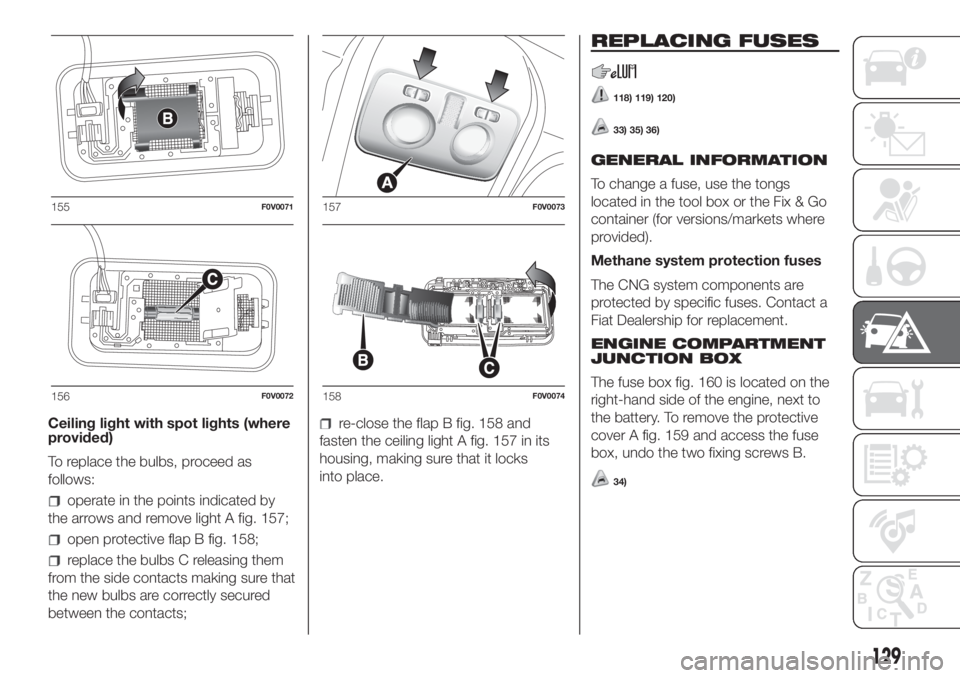
Ceiling light with spot lights (where
provided)
To replace the bulbs, proceed as
follows:
operate in the points indicated by
the arrows and remove light A fig. 157;
open protective flap B fig. 158;
replace the bulbs C releasing them
from the side contacts making sure that
the new bulbs are correctly secured
between the contacts;
re-close the flap B fig. 158 and
fasten the ceiling light A fig. 157 in its
housing, making sure that it locks
into place.
REPLACING FUSES
118) 119) 120)
33) 35) 36)
GENERAL INFORMATION
To change a fuse, use the tongs
located in the tool box or the Fix & Go
container (for versions/markets where
provided).
Methane system protection fuses
The CNG system components are
protected by specific fuses. Contact a
Fiat Dealership for replacement.
ENGINE COMPARTMENT
JUNCTION BOX
The fuse box fig. 160 is located on the
right-hand side of the engine, next to
the battery. To remove the protective
cover A fig. 159 and access the fuse
box, undo the two fixing screws B.
34)
155F0V0071
156F0V0072
157F0V0073
158F0V0074
129
Page 132 of 272
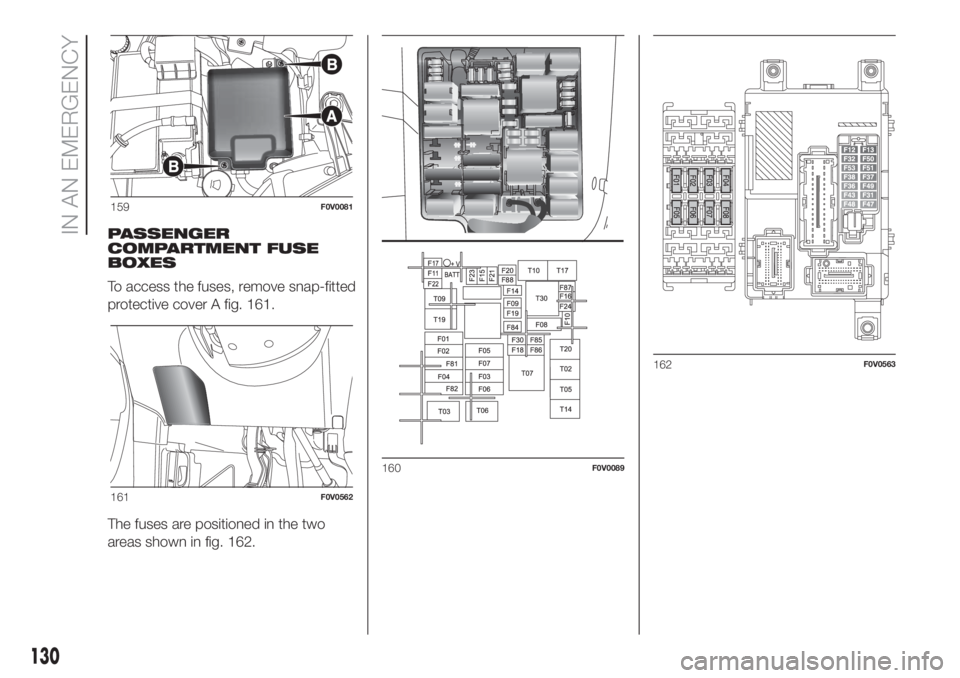
PASSENGER
COMPARTMENT FUSE
BOXES
To access the fuses, remove snap-fitted
protective cover A fig. 161.
The fuses are positioned in the two
areas shown in fig. 162.
159F0V0081
161F0V0562
160F0V0089
162F0V0563
130
IN AN EMERGENCY
Page 133 of 272
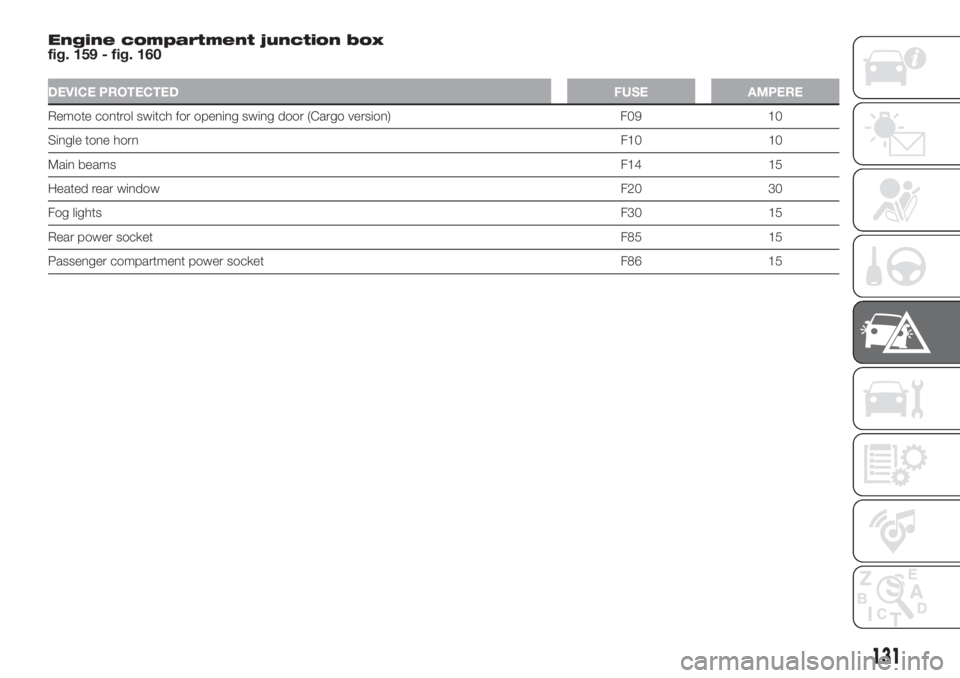
Engine compartment junction box
fig. 159 - fig. 160
DEVICE PROTECTEDFUSE AMPERE
Remote control switch for opening swing door (Cargo version) F09 10
Single tone hornF10 10
Main beamsF14 15
Heated rear windowF20 30
Fog lightsF30 15
Rear power socketF85 15
Passenger compartment power socket F86 15
131
Page 134 of 272
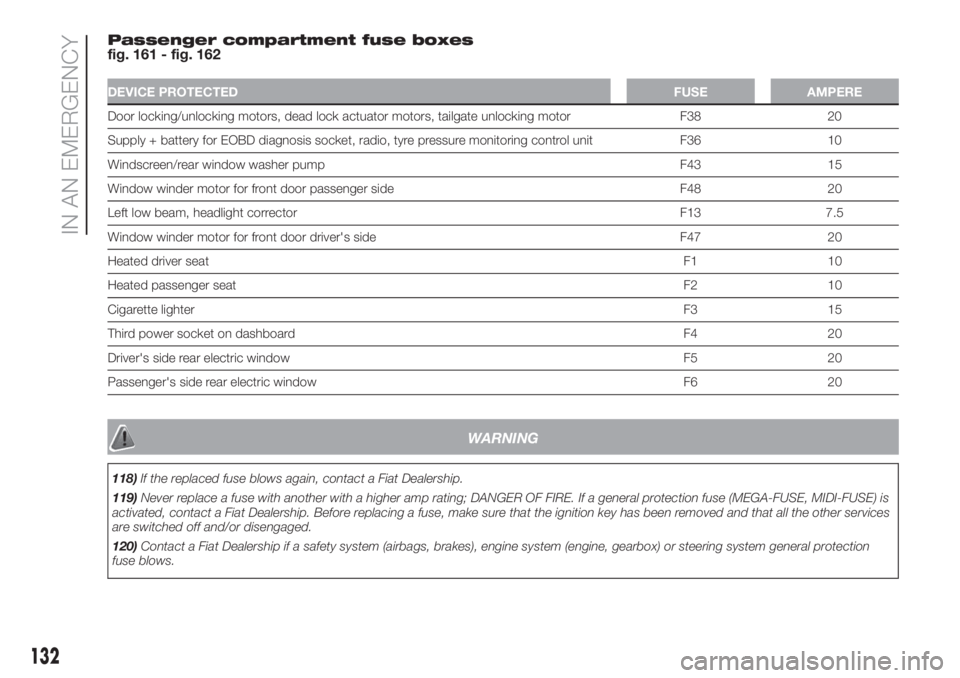
Passenger compartment fuse boxes
fig. 161 - fig. 162
DEVICE PROTECTEDFUSE AMPERE
Door locking/unlocking motors, dead lock actuator motors, tailgate unlocking motor F38 20
Supply + battery for EOBD diagnosis socket, radio, tyre pressure monitoring control unit F36 10
Windscreen/rear window washer pump F43 15
Window winder motor for front door passenger side F48 20
Left low beam, headlight corrector F13 7.5
Window winder motor for front door driver's side F47 20
Heated driver seatF1 10
Heated passenger seatF2 10
Cigarette lighterF3 15
Third power socket on dashboard F4 20
Driver's side rear electric window F5 20
Passenger's side rear electric window F6 20
WARNING
118)If the replaced fuse blows again, contact a Fiat Dealership.
119)Never replace a fuse with another with a higher amp rating; DANGER OF FIRE. If a general protection fuse (MEGA-FUSE, MIDI-FUSE) is
activated, contact a Fiat Dealership. Before replacing a fuse, make sure that the ignition key has been removed and that all the other services
are switched off and/or disengaged.
120)Contact a Fiat Dealership if a safety system (airbags, brakes), engine system (engine, gearbox) or steering system general protection
fuse blows.
132
IN AN EMERGENCY
Page 135 of 272
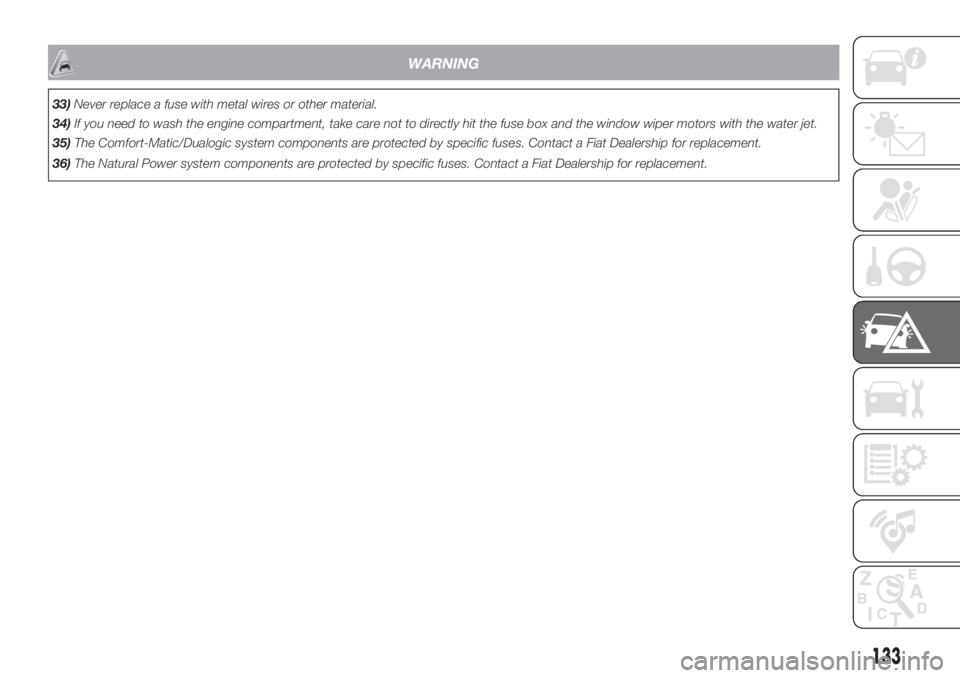
WARNING
33)Never replace a fuse with metal wires or other material.
34)If you need to wash the engine compartment, take care not to directly hit the fuse box and the window wiper motors with the water jet.
35)The Comfort-Matic/Dualogic system components are protected by specific fuses. Contact a Fiat Dealership for replacement.
36)The Natural Power system components are protected by specific fuses. Contact a Fiat Dealership for replacement.
133
Page 136 of 272
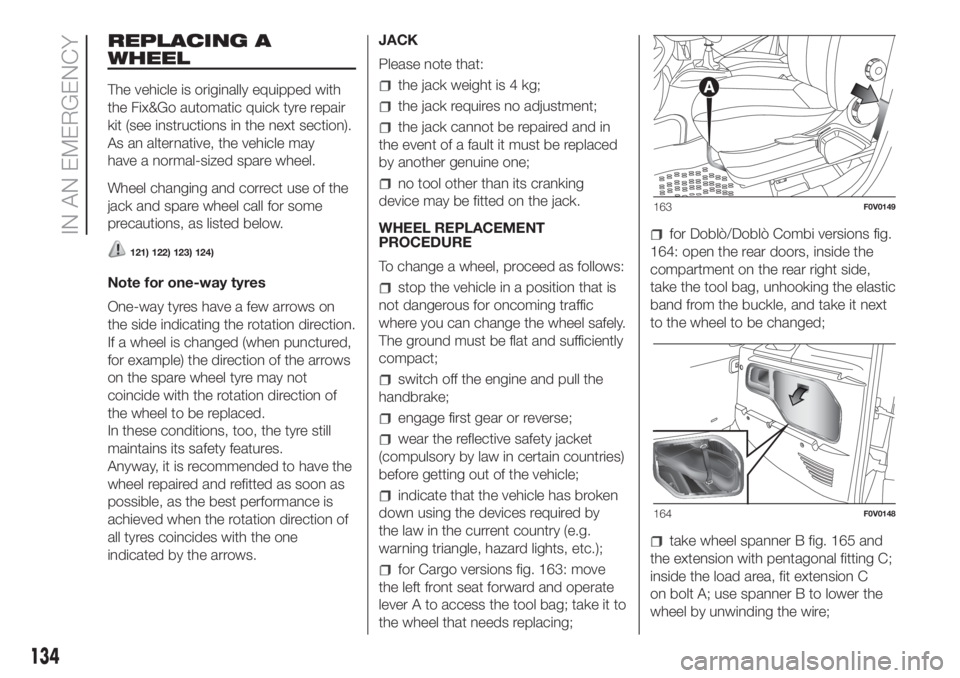
REPLACING A
WHEEL
The vehicle is originally equipped with
the Fix&Go automatic quick tyre repair
kit (see instructions in the next section).
As an alternative, the vehicle may
have a normal-sized spare wheel.
Wheel changing and correct use of the
jack and spare wheel call for some
precautions, as listed below.
121) 122) 123) 124)
Note for one-way tyres
One-way tyres have a few arrows on
the side indicating the rotation direction.
If a wheel is changed (when punctured,
for example) the direction of the arrows
on the spare wheel tyre may not
coincide with the rotation direction of
the wheel to be replaced.
In these conditions, too, the tyre still
maintains its safety features.
Anyway, it is recommended to have the
wheel repaired and refitted as soon as
possible, as the best performance is
achieved when the rotation direction of
all tyres coincides with the one
indicated by the arrows.JACK
Please note that:
the jack weight is 4 kg;
the jack requires no adjustment;
the jack cannot be repaired and in
the event of a fault it must be replaced
by another genuine one;
no tool other than its cranking
device may be fitted on the jack.
WHEEL REPLACEMENT
PROCEDURE
To change a wheel, proceed as follows:
stop the vehicle in a position that is
not dangerous for oncoming traffic
where you can change the wheel safely.
The ground must be flat and sufficiently
compact;
switch off the engine and pull the
handbrake;
engage first gear or reverse;
wear the reflective safety jacket
(compulsory by law in certain countries)
before getting out of the vehicle;
indicate that the vehicle has broken
down using the devices required by
the law in the current country (e.g.
warning triangle, hazard lights, etc.);
for Cargo versions fig. 163: move
the left front seat forward and operate
lever A to access the tool bag; take it to
the wheel that needs replacing;
for Doblò/Doblò Combi versions fig.
164: open the rear doors, inside the
compartment on the rear right side,
take the tool bag, unhooking the elastic
band from the buckle, and take it next
to the wheel to be changed;
take wheel spanner B fig. 165 and
the extension with pentagonal fitting C;
inside the load area, fit extension C
on bolt A; use spanner B to lower the
wheel by unwinding the wire;
163F0V0149
164F0V0148
134
IN AN EMERGENCY
Page 137 of 272
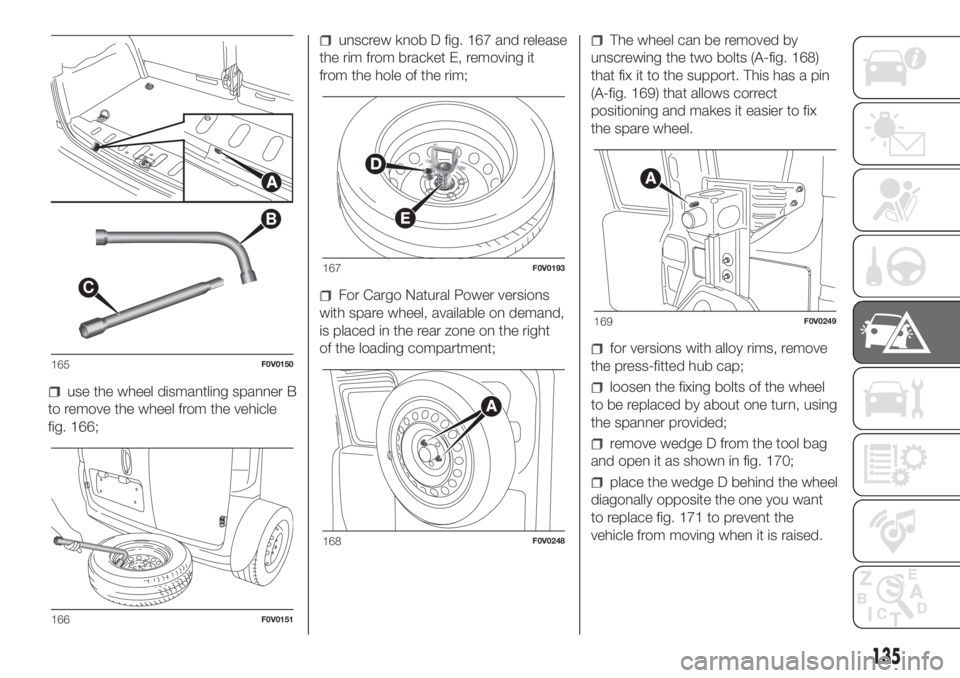
use the wheel dismantling spanner B
to remove the wheel from the vehicle
fig. 166;
unscrew knob D fig. 167 and release
the rim from bracket E, removing it
from the hole of the rim;
For Cargo Natural Power versions
with spare wheel, available on demand,
is placed in the rear zone on the right
of the loading compartment;
The wheel can be removed by
unscrewing the two bolts (A-fig. 168)
that fix it to the support. This has a pin
(A-fig. 169) that allows correct
positioning and makes it easier to fix
the spare wheel.
for versions with alloy rims, remove
the press-fitted hub cap;
loosen the fixing bolts of the wheel
to be replaced by about one turn, using
the spanner provided;
remove wedge D from the tool bag
and open it as shown in fig. 170;
place the wedge D behind the wheel
diagonally opposite the one you want
to replace fig. 171 to prevent the
vehicle from moving when it is raised.
B
C
165F0V0150
166F0V0151
167F0V0193
168F0V0248
169F0V0249
135
Page 138 of 272
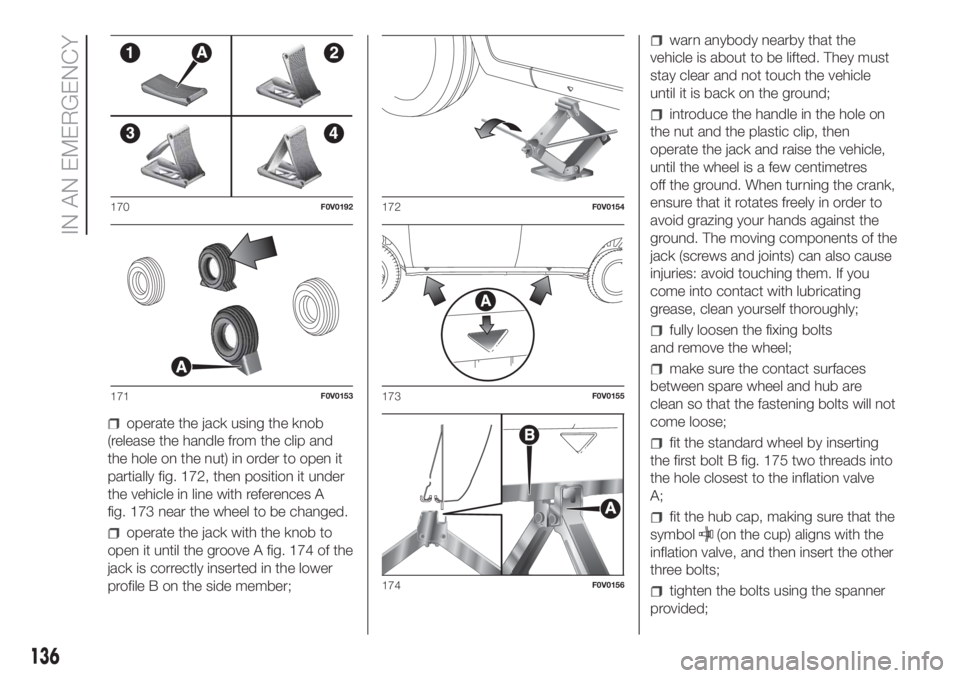
operate the jack using the knob
(release the handle from the clip and
the hole on the nut) in order to open it
partially fig. 172, then position it under
the vehicle in line with references A
fig. 173 near the wheel to be changed.
operate the jack with the knob to
open it until the groove A fig. 174 of the
jack is correctly inserted in the lower
profile B on the side member;
warn anybody nearby that the
vehicle is about to be lifted. They must
stay clear and not touch the vehicle
until it is back on the ground;
introduce the handle in the hole on
the nut and the plastic clip, then
operate the jack and raise the vehicle,
until the wheel is a few centimetres
off the ground. When turning the crank,
ensure that it rotates freely in order to
avoid grazing your hands against the
ground. The moving components of the
jack (screws and joints) can also cause
injuries: avoid touching them. If you
come into contact with lubricating
grease, clean yourself thoroughly;
fully loosen the fixing bolts
and remove the wheel;
make sure the contact surfaces
between spare wheel and hub are
clean so that the fastening bolts will not
come loose;
fit the standard wheel by inserting
the first bolt B fig. 175 two threads into
the hole closest to the inflation valve
A;
fit the hub cap, making sure that the
symbol
(on the cup) aligns with the
inflation valve, and then insert the other
three bolts;
tighten the bolts using the spanner
provided;
170F0V0192
171F0V0153
172F0V0154
173F0V0155
174F0V0156
136
IN AN EMERGENCY
Page 139 of 272
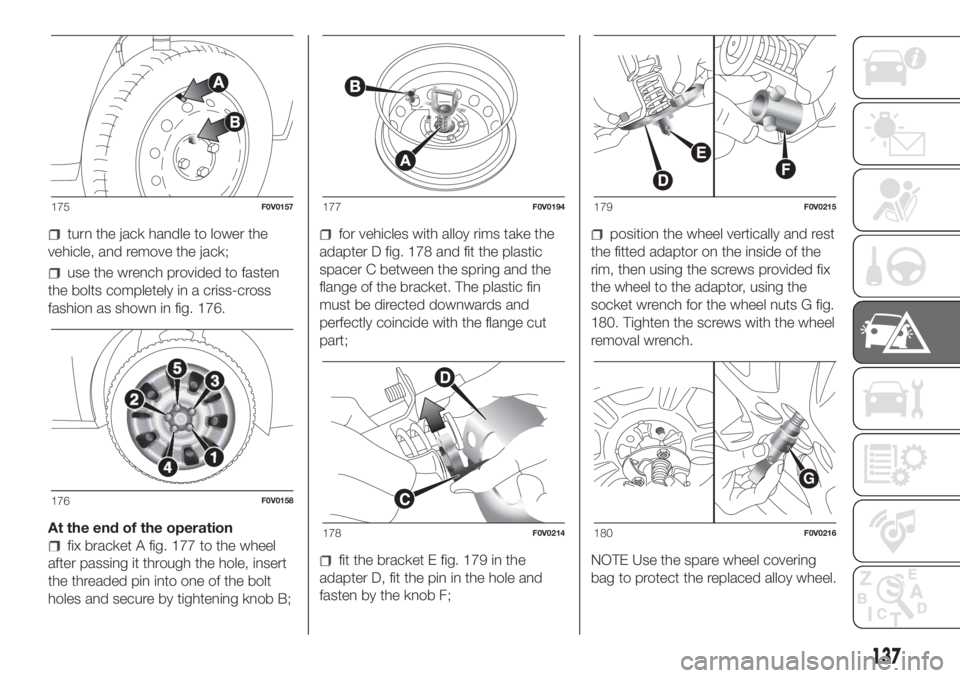
turn the jack handle to lower the
vehicle, and remove the jack;
use the wrench provided to fasten
the bolts completely in a criss-cross
fashion as shown in fig. 176.
At the end of the operation
fix bracket A fig. 177 to the wheel
after passing it through the hole, insert
the threaded pin into one of the bolt
holes and secure by tightening knob B;
for vehicles with alloy rims take the
adapter D fig. 178 and fit the plastic
spacer C between the spring and the
flange of the bracket. The plastic fin
must be directed downwards and
perfectly coincide with the flange cut
part;
fit the bracket E fig. 179 in the
adapter D, fit the pin in the hole and
fasten by the knob F;
position the wheel vertically and rest
the fitted adaptor on the inside of the
rim, then using the screws provided fix
the wheel to the adaptor, using the
socket wrench for the wheel nuts G fig.
180. Tighten the screws with the wheel
removal wrench.
NOTE Use the spare wheel covering
bag to protect the replaced alloy wheel.
175F0V0157
176F0V0158
177F0V0194
178F0V0214
179F0V0215
G
180F0V0216
137
Page 140 of 272
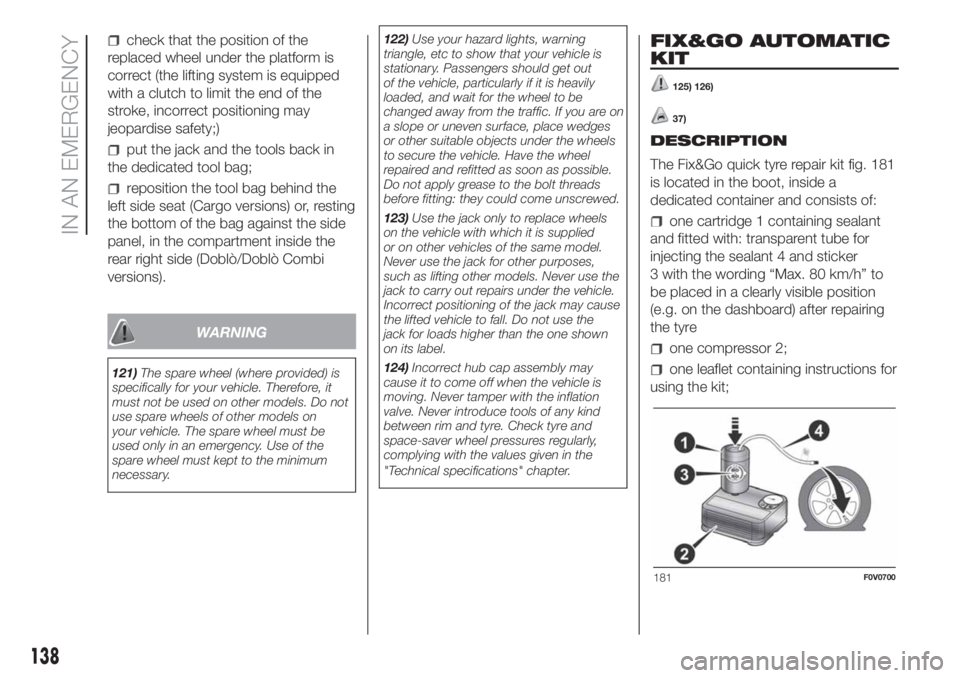
check that the position of the
replaced wheel under the platform is
correct (the lifting system is equipped
with a clutch to limit the end of the
stroke, incorrect positioning may
jeopardise safety;)
put the jack and the tools back in
the dedicated tool bag;
reposition the tool bag behind the
left side seat (Cargo versions) or, resting
the bottom of the bag against the side
panel, in the compartment inside the
rear right side (Doblò/Doblò Combi
versions).
WARNING
121)The spare wheel (where provided) is
specifically for your vehicle. Therefore, it
must not be used on other models. Do not
use spare wheels of other models on
your vehicle. The spare wheel must be
used only in an emergency. Use of the
spare wheel must kept to the minimum
necessary.122)Use your hazard lights, warning
triangle, etc to show that your vehicle is
stationary. Passengers should get out
of the vehicle, particularly if it is heavily
loaded, and wait for the wheel to be
changed away from the traffic. If you are on
a slope or uneven surface, place wedges
or other suitable objects under the wheels
to secure the vehicle. Have the wheel
repaired and refitted as soon as possible.
Do not apply grease to the bolt threads
before fitting: they could come unscrewed.
123)Use the jack only to replace wheels
on the vehicle with which it is supplied
or on other vehicles of the same model.
Never use the jack for other purposes,
such as lifting other models. Never use the
jack to carry out repairs under the vehicle.
Incorrect positioning of the jack may cause
the lifted vehicle to fall. Do not use the
jack for loads higher than the one shown
on its label.
124)Incorrect hub cap assembly may
cause it to come off when the vehicle is
moving. Never tamper with the inflation
valve. Never introduce tools of any kind
between rim and tyre. Check tyre and
space-saver wheel pressures regularly,
complying with the values given in the
"Technical specifications" chapter.
FIX&GO AUTOMATIC
KIT
125) 126)
37)
DESCRIPTION
The Fix&Go quick tyre repair kit fig. 181
is located in the boot, inside a
dedicated container and consists of:
one cartridge 1 containing sealant
and fitted with: transparent tube for
injecting the sealant 4 and sticker
3 with the wording “Max. 80 km/h” to
be placed in a clearly visible position
(e.g. on the dashboard) after repairing
the tyre
one compressor 2;
one leaflet containing instructions for
using the kit;
181F0V0700
138
IN AN EMERGENCY